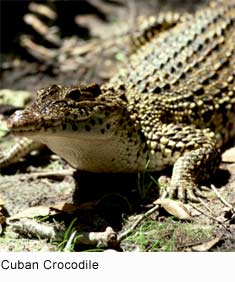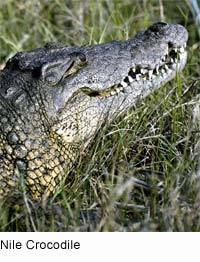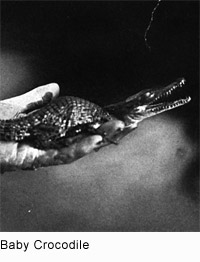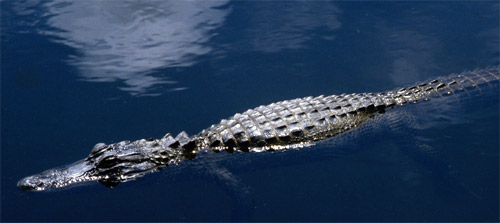|

Just the Facts: Crocodiles (colloquially called crocs) are large aquatic reptiles that live throughout the Tropics in Africa, Asia, the Americas and Australia. Crocodiles tend to congregate in slow-moving rivers and lakes, and feed on a wide variety of living and dead mammals and fish. Some species, notably the Saltwater crocodile of Australia and the Pacific islands, have been known to venture far out to sea. They are an ancient lineage, and are believed to have changed little since the time of the dinosaurs.

Warning! The larger species of crocodiles can be very dangerous to humans. The Saltwater and Nile crocodiles are the most dangerous, killing hundreds of people each year in parts of South-East Asia and Africa. American alligators, Mugger crocodiles and possibly the endangered Black Caiman, are also very dangerous to humans.
 Lock Jaw: Crocodiles are very fast over short distances, even out of water. Lock Jaw: Crocodiles are very fast over short distances, even out of water.
They have extremely powerful jaws and sharp teeth for tearing flesh, but cannot open their mouth if it is held closed, hence there are stories of people escaping from the long-snouted Nile Crocodile by holding its jaws shut.
Indeed, zoologists will often subdue crocodiles for study or transport by taping their jaws or holding their jaws shut with large rubber bands cut from automobile inner tubes. All large crocodiles also have sharp welters and powerful claws. They have limited lateral movement in their neck, so on land one can find protection by getting even a small tree between the crocodile's jaws and oneself.
Ambush Hunters: Crocodiles are ambush hunters, waiting for fish or land animals to come close, then rushing out to attack. As cold-blooded predators, they can survive long periods without food, and rarely need to actively go hunting.
 The crocodile's bite strength is up to 3,000 pounds per square inch, comparing to just 100 psi for a labrador retriever or 350 psi for a large shark. Despite their slow appearance, crocodiles are the top predators in their environment, and various species have been observed attacking and killing lions, large ungulates and even sharks. The crocodile's bite strength is up to 3,000 pounds per square inch, comparing to just 100 psi for a labrador retriever or 350 psi for a large shark. Despite their slow appearance, crocodiles are the top predators in their environment, and various species have been observed attacking and killing lions, large ungulates and even sharks.
Cooperation Nation: A famous exception is the Egyptian Plover which is said to enjoy a symbiotic relationship with the crocodile. According to unauthenticated reports, the plover feeds on parasites that infest the crocodile's mouth and the reptile will open its jaws and allow the bird to enter to clean out the mouth.
On the Menu: Crocodiles eat fish, birds, mammals and occasionally smaller crocodiles. Wild crocodiles are protected in many parts of the world, but they also are farmed commercially. Their hide is tanned and used to make leather goods such as shoes and handbags, whilst crocodile meat is also considered a delicacy in many parts of the world. The most commonly farmed species are the Saltwater and Nile crocodiles, while a hybrid of the Saltwater and the rare Siamese Crocodile is also bred in Asian farms. Farming has resulted in an increase in the Saltwater Crocodile population in Australia, as eggs are usually harvested from the wild, so landowners have an incentive to conserve crocodile habitat.
Big Birds? Crocodiles are more closely related to birds and dinosaurs than to most animals classified as reptiles (though all of these are thought to probably be more closely related to each other than to Testudines (turtles and tortoises), and have correspondingly unusual features for reptiles, such as a four-chambered heart).
 World's Largest Reptile: The largest species of crocodile, also Earth's largest reptile, is the Saltwater Crocodile, found in northern Australia and throughout South-east Asia. There is a report of a Saltwater crocodile in Australia that was 27 feet (8.2 m) long. World's Largest Reptile: The largest species of crocodile, also Earth's largest reptile, is the Saltwater Crocodile, found in northern Australia and throughout South-east Asia. There is a report of a Saltwater crocodile in Australia that was 27 feet (8.2 m) long.
There is also a skull of a salt water crocodile from Orissa, India that is very large and the animal is estimated to have been 21-23 feet (6.4 to 7 m) long. The Largest Crocodile ever held in captivity is an Estuarine/Siamese hybrid named "YAI" (Born10 June 1972) at the famous Samutprakarn Crocodile Farm and Zoo, Thailand. He measures 6 m. (19 ft. 8 in.) in length and weighs 1,114.27 kg. (2,465 lb.)
World Record: On June 16, 2006, A 23-feet (7.1m) giant saltwater crocodile in Orissa, India and was crowned the world's largest living crocodile. It lives in Bhitarkanika Wildlife Sanctuary and in June 2006, was entered in the Guinness Book of World Records.

Medicinal Blood? Scientists in the United States have isolated a powerful agent in crocodile blood which could help conquer human infections immune to standard antibiotics.
The discovery was made thanks to the curiosity of Jill Fullerton-Smith, a BBC science producer filming a documentary on salt-water crocodiles in Australia, (now former-) BBC Director-General Greg Dyke revealed.

All text is available under the terms
of the GNU Free Documentation License
|

